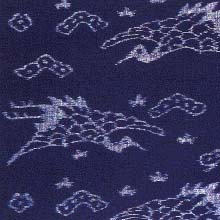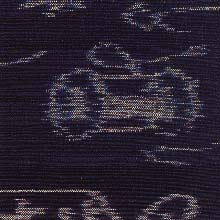Weave (p. 113 )
1. Produced in Yonago City, Sakaiminato City, Yodoecho, Saihakugun, Tottori Prefecture.
2.Characteristics: Threads are taken manually from cotton wool. Threads for weft are marked with Chinese ink with a special thread as a measure. Threads for weft is dyed in indigo after they are tied tightly with hemp rind. Patterns and designs are woven only with the weft. Figures close to daily life are woven including birds, flowers, fans and names. It is called "E Gasuri," figure kasuri, and also called "Hama Gasuri."
3. Uses: Clothing, sashes, bedding, cushions, "Noren,"(shop curtains), wall hangings, table centers.
4. History: As the soil had not been good for crops, efforts were made to cultivate cotton, producing quality cotton, called "Hakushu"(Tottori Prefecture) cotton, which was marketed in Osaka in the Meiwa and Anei Eras(1764-81). "kasuri" was first woven in the Bunka Era(1804-1818) when the "Kasuri" technique was transmitted from Iyo(Ehime prefecture). The production continued to the Taisho Period, but the traditional Kasuri(handspun) has not been woven as it needs manpower. Instead, only Yumigahama Kasuri, which is chemically dyed, Machine spun and woven, is produced to the amount of some 10,000 "tan"(amount of cloth enough for an adult) every year today.




